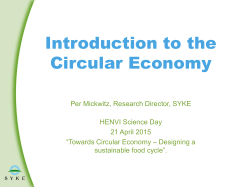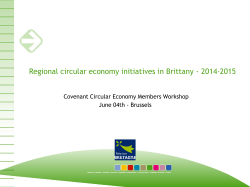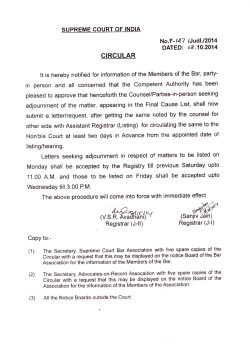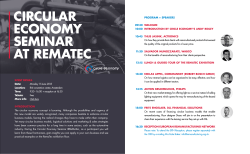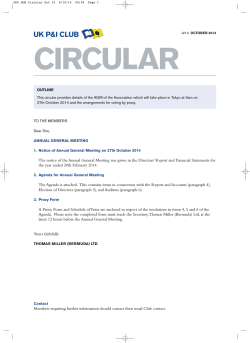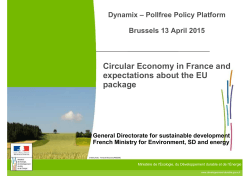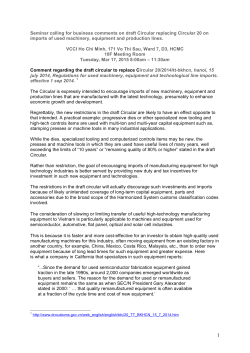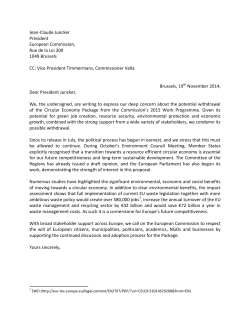
Circular economy - The Global Cleantech Summit 2015
GLOBAL CLEANTECH SUMMIT 2015 HELSINKI, 8TH OF SEPTEMBER, 2015 MR. PEKKA OJANPÄÄ, PRESIDENT AND CEO LASSILA & TIKANOJA PLC ©1 Lassila & Tikanoja Oyj BACKGROUND x2 THE AMOUNT OF WASTE WILL DOUBLE by 2025, reaching 6.5 million tonnes per day. 1) 1) 2) +3 THREE BILLION NEW CONSUMERS IN MIDINCOME RANGE use money by 2030. 2) World Bank OECD © Lassila & Tikanoja Oyj billion 2 CIRCULAR ECONOMY WILL BECOME A REALITY providing new business opportunities. WASTE IS NO LONGER A THREAT BUT AN OPPORTUNITY 1960 Landfills Recycling • Preventing the hygienic threat • Recovery and safe burial of waste • • • • 1980 © Lassila & Tikanoja Oyj 1990 2000 2010 Sorting at the source Priority order/waste hierarchy Producer liability Gradual elimination of landfills 2020 2030 2040 2050 Incineration Circular economy • Aim: obliteration of waste • Waste recovery at a modest level • Expensive long-term solutions • • • • • 3 Closed cycle Reuse and remanufacture Repair From consumption to utilization New technologies and service models CIRCULAR ECONOMY INTERACTIVE SYSTEM1) 1) Ellen MacArthur Foundation © Lassila & Tikanoja Oyj 4 CIRCULAR ECONOMY CHANGES TRADITIONAL VALUE CHAINS BY MOVING UP IN WASTE HIERARCHY Prevention Using less material in design and manufacture. Keeping products for longer, re-use. Using less hazardous material. Preparing for re-use Checking, cleaning, repairing, refurbishing, repair, whole items or spare parts. Recycling Turning waste into a new substance or product. Includes composting of meets quality protocols. Other recovery Including anaerobic digestion, incineration with energy recovery, gasification and pyrolysis which produce energy and materials from waste; some backfilling operations. Disposal Landfill and incineration without energy recovery. © Lassila & Tikanoja Oyj 5 PRODUCER LIABILITY PROVIDES A GOOD FOUNDATION FOR THE DEVELOPMENT OF CIRCULAR ECONOMY In product design, the environment and reuse throughout the product life cycle (Ecodesign) must be taken into account Operational economy solutions encourage the design of more durable products Renting and leasing models are a means for producers to ensure the return flow Encouragement of voluntary manufacturer-specific recovery systems Shift from regulations towards consumer driven demand © Lassila & Tikanoja Oyj 6 EXAMPLE OF THE DEVELOPMENT OF CIRCULAR ECONOMY © Lassila & Tikanoja Oyj 7 PRIVATE SECTOR LEADS CIRCULAR ECONOMY INNOVATIONS © Lassila & Tikanoja Oyj 8 WE CIRCULATE PALLETS © Lassila & Tikanoja Oyj 9 CONCLUSIONS Businesses are capable of changing their operations towards sustainable economy, actually the transition to circular economy is already underway Circular economy is a positive opportunity for Europe - We can ensure self-sufficiency in energy and raw-materials Technology and service solutions are a major employment and investment opportunity Circular economy will be achieved in a society which recycles - Regulation is needed to ensure resource-efficiency on all levels (recycling targets, ecodesign, support and reinforcement of recycled raw-material markets) To achieve effective recovery of recycled raw-materials we need to strengthen the role of the producer in the value chain–and to diminish that of the state. Market needs a stable and predictable operating environment (regulation) and a well-functioning marketplace based on market economy and consumers’ freedom to choose. © Lassila & Tikanoja Oyj 10 TAUSTAMATERIAALIA © Lassila & Tikanoja Oyj CIRCULAR ECONOMY PRINCIPLE1) A circular economy is one that is restorative by design, and which aims to keep products, components and materials at their highest utility and value, at all times. 1 2 3 4 5 1) Circular economy is a global economic model that decouples economic growth and development from the consumption of finite resources; Distinguishes between and separates technical and biological materials, keeping them at their highest value at all times. Focuses on effective design and use of materials to optimise their flow and maintain or increase technical and natural resource stocks; Provides new opportunities for innovation across fields such as product design, service and business models, food, farming, biological feedstocks and products; Establishes a framework and building blocks for a resilient system able to work in the longer term. Ellen MacArthur Foundation © Lassila & Tikanoja Oyj 13 STRATEGIC OPPORTUNITY DRIVERS OF CLEANTECH1) Cost of scaling going down – fossil fuel costs going up Influx of private capital Governments compete to build regional economies and develop high- paying jobs Shift of regulatory and financial support to more efficient technologies Explosive demand for energy and water infrastructure in China, India, and other developing nations Consumer demand for cleanerproducts and services Certainty of climate change drives business innovation © Lassila & Tikanoja Oyj 14
© Copyright 2025

